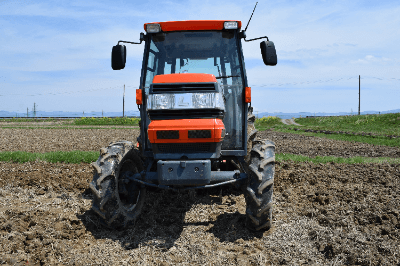What Is an Agricultural Tractor?

An agricultural tractor is the most commonly used farm machinery for efficiently conducting agricultural operations.
Equipped with large tires and powerful torque, it is employed for tasks such as plowing, grass cutting, seeding, and harvesting. Capable of attaching multiple implements, it can adapt to various agricultural activities.
Agricultural tractors are indispensable in agriculture, addressing challenges like labor shortages and enhancing overall efficiency. Note that while there are tractors designed for towing, here we focus on those specifically used in agriculture.
Uses of Agricultural Tractor
Agricultural tractors find applications in various agricultural tasks, offering versatility through the interchangeability of attachments.
1. Plowing
Plowing involves preparing the soil before planting, loosening, mixing, and weeding. Implements like rotary plows or plows are attached for this task.
2. Field Leveling
Field leveling is essential to prevent issues like waterlogging and uneven water distribution in rice paddies. Implements like leveling harrows or rotary harrows are attached for this purpose.
3. Fertilization
Fertilization involves spreading nutrients necessary for crop growth on the field. Implements like fertilizer spreaders or broadcast spreaders are attached for this task.
4. Ridge Making
Ridge-making is the process of creating ridges in the field to improve water repellency and aeration. Essential for crop root development, ridge makers or soil bedders are attached for this task.
5. Mulching
Mulching involves covering ridges with plastic or polyethylene film to prevent soil dryness and disease transmission. Implements like mulching rotaries are used for this operation.
6. Snow Removal
In snow-prone areas, agricultural tractors are equipped with snow blades or snow rakes for snow removal operations.
7. Others
They are also utilized for tasks like seeding, grass cutting, and the application of soil amendments and herbicides.
Characteristics of Agricultural Tractor
Advantages
The major strength of agricultural tractors lies in their diverse range of attachments. The ability to switch attachments allows for the execution of multiple tasks efficiently. Another advantage is their capability to operate in softer terrains.
Disadvantages
One of the drawbacks of agricultural tractors is the higher cost due to the need for multiple attachments. Agricultural tractors require specific attachments for each task, contributing to increased costs.
Types of Agricultural Tractor
The drive systems of agricultural tractors are commonly known as wheeled models, but there are two other types. These include “Half-Track,” with wheels in the front and crawler tracks in the rear, and “Full-Track,” equipped with crawler tracks only.
1. Wheeled Type
Wheeled tractors excel in on-road performance, facilitating long-distance travel. They are also adept at maneuvering in tight spaces, allowing for easy operation in confined areas.
2. Half-Track
Combining the advantages of wheeled and full-track types, half-track tractors provide efficient operation in wetland conditions, even though on-road performance is less than that of wheeled models.
3. Full-Track
Full-track tractors, with their wide ground contact area, demonstrate significant power in tasks conducted in waterlogged fields. They are also capable of operating after rain or on snowy surfaces.
How to Choose an Agricultural Tractor
When selecting an agricultural tractor, factors such as the size of the work area, terrain characteristics, and specific purposes need to be considered. Choosing the right tractor size, required horsepower, and drive system for each task is crucial.
Consideration of maintenance costs, including fuel expenses and repair estimates, is essential to choose an economically sustainable agricultural tractor.
Other Information on Agricultural Tractor
Driver’s License for Agricultural Tractors
For the use of agricultural tractors on private property, such as farms or private roads, a specific driver’s license is not required. However, if the tractor needs to travel on public roads, a driver’s license is mandatory.
1. Small Special License or Regular License
A small special vehicle is defined as having a length, width, height, and maximum speed of 4.7m or less, 1.7m or less, 2.0m or less, and 15km/h or less, respectively. If you possess a regular driver’s license, you can operate a small special vehicle.
2. Large Special License
If any specification of the small special vehicle exceeds the defined limits, a large special license is necessary. Acquiring a large special license enables the operation of certain construction machines besides agricultural tractors.
For those who do not intend to drive large vehicles other than agricultural tractors, obtaining a “Large Special License (Limited to Agricultural Workers)” is recommended.